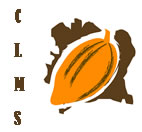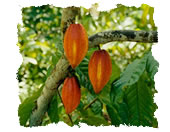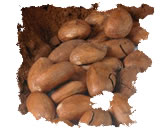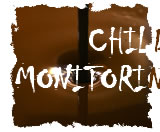|
|
|
Cocoa farming process
|
The cocoa farming process (technical itinerary in the cocoa sector) is as follows:
|
| |
| |
 |
|
Land preparation and shadowed construction
|
The land preparation in old forestry areas focuses on cutting of wood, cutting down and cleaning of short trees after burning. The cutting of wood must be performed through a selection process; i.e., eliminate the adversary trees to the cocoa tree such as samba and cola nitida.
Also, the method which is recommended is the plantation on the shadow packaged after a total cutting, thus favoring positive conditions for a development of the plantation.
|
|
| |
 |
|
Staking-out to the plantation
|
Several plans of plantations could be adopted (square plantations, in triangle) but the simpler one and the most frequent one is the plantation in lines. This method help ease the upkeeping, control and phyto-sanitary treatment operations. When the soil and the shading are correctly arranged, a stake with care, with the help of bush stake of one meter of height, must be done to materialize the place of each of the weeding.
The plantation devices recommended currently in Côte d'Ivoire are three meters between the lines and 2 to 2.5 meter on the lines, i.e., 1,320 to 1,660 trees per hectare. It is recommended to make the hole once the first rains have help soften enough the soil for the work to be done without difficulties. A hole of 40 cm in all senses is perfectly convenient.
The planting is taking place when the raining season is there. The best weeds are loaded from the nursery to the field, early in the morning, and then placed in the holes. The weed must be stripped from the bag before being put in the hole. One must pack the soil around one's foot. The collar must be at the same level that the soil. Then, after the planting, it is good to circle the weed with some protection.
|
|
| |
 |
|
Upkeeping the planting
|
| 1. |
Filling out of lefts seedlings
|
| |
The left seedlings are due generally to hazardous reasons, more often damages from some insects or injuries during the cleaning process of the plantation. Their replacement consists of planting other plants. This must be done as soon as possible, preferably during the first year.
|
|
| 2. |
Shading Adjustment
|
| |
The adjustment of the shading is very important for a young plantation. During the first year, a thick shading scheme is necessary (leave only 25 to 50% of the total light). It must be progressively reduced to leave 50 to 75% of the total light when the cocoa trees have reached their full development process (from three years).
|
|
| 3. |
Soil upkeeping
|
| |
The soil upkeeping works consist essentially of eliminating bad herbs. The use of an appropriate shading, the application of in the plantation, the upkeeping of a coverage in the interlines help control the young plantation. In an adult plantation well formed, the crowns of trees form a continuous cover dense and above the soil. This cover is covered by a thick pile of deaf leaves where no bad herb can develop. (the application of a straw in the plantation lines, the upkeeping of a cover in the interlines facilitate this control in the young plantation.
In the adult plantation, the crowns of the trees form continuous and dense cover above the soil. This one is in this case recovered of a thick pile of dead leaves where no plant adventice has developed.
|
|
| 4. |
Pruning of the cocoa tree
|
| |
The operation of pruning is an upkeeping operation. It consists of eliminating the advantice to favor the formation of the crown. Two types of height are available: the height of the formation in order to detect the best stems, and the height of upkeeping.
|
|
| 5. |
Phyto-sanitary treatments and contribution of fertilizers
|
| |
On the young plantations, a phyto-sanitary supervision must be regularly undertaken because some insect damages not harmful on adult trees could be damaging for seedlings when there are many ones, and endangering their development.
From the first two years, the phyto-sanitary treatments on the cocoa planting focus on the mirides or capsides (parasite insects of the cocoa trees). The anti-capside treatments are undertaken by the application of specific insecticides through sprays. There are two types of treatments per year when insecticides of third generation are utilized (most often used). The periods of treatment are January-February and from July to August.
In the case of an intensive culture undertaken with permanent shading and using a vegetal material selected for its high productivity potential, the introduction of pesticides is necessary.
|
|
| 6. |
Cleaning
|
| |
The cleaning consists of cutting the plantation, proceed to cutting down of the land and to the suppression of the branches. This operation is performed with a machete. In the non-productive plantations, there must be at least three cleaning processes during a season (October to September of the following year). The cultural operations before the cutting-up is necessary, in the productive plantation, are the phyto-sanitary treatment and the harvesting. In the other hand, the egourmandage and the suppression of branches could be undertaken simultaneously.
|
|
| 7. |
Harversting
( video ) |
| |
It is more often their color change by which the maturity of pods is noticed, the green changing to yellow, and the red to orange. The harvesting must be undertaken at regular intervals ranging from ten to fifteen days, and never exceed three weeks. The picking is a delicate operation where much care must be given not to hurt the small flower cushions. The picking of pods of trunk and lower branches is done easily with a machete. Those from higher branches require the use of a tool with a haft for pruning. |
|
| 8. |
Cocoa cracking
|
| |
After the harvesting, the pods are carried out near the location where the beans must be fermented. The cocoa cracking will consist of breaking the fruit and take away the beans which, separated from the placenta, will be then processed to the fermentation process. The cocoa cracking is done with a club.
|
|
| 9. |
Fermentation
( video ) |
| |
|
Before being dried, the fresh cocoa beans must be treated through a process with the main objective of: |
| |
 |
Taking away the mucilaginous pulp round it. |
| |
 |
Provokes the death of the embryo and therefore prevent the germination of beans allowing their conservation |
| |
 |
Help bring the precursors of the chocolate flavor.
This is the fermentation process. To reach this process, beans are put together in protected piles outside with banana leaves. |
| |
|
The suggested length for the fermentation process in Côte d’Ivoire is 6 days with a melting of piles every two days. |
|
|
| 10. |
Drying
( video ) |
| |
The drying process has for objective to bring the percentage of moisture of fermented beans, which his approximately 60%, at a value of 6 to 7%. The moisture of dried cocoa bean must be maintained at this level if we want to insure the good conditions of conservation.
The methods used for the drying of cocoa could be classified into two large groups: natural drying (solar) on the grids arranged appropriately; and the artificial drying through thermal drying outlets.
|
|
|
|
|
|









